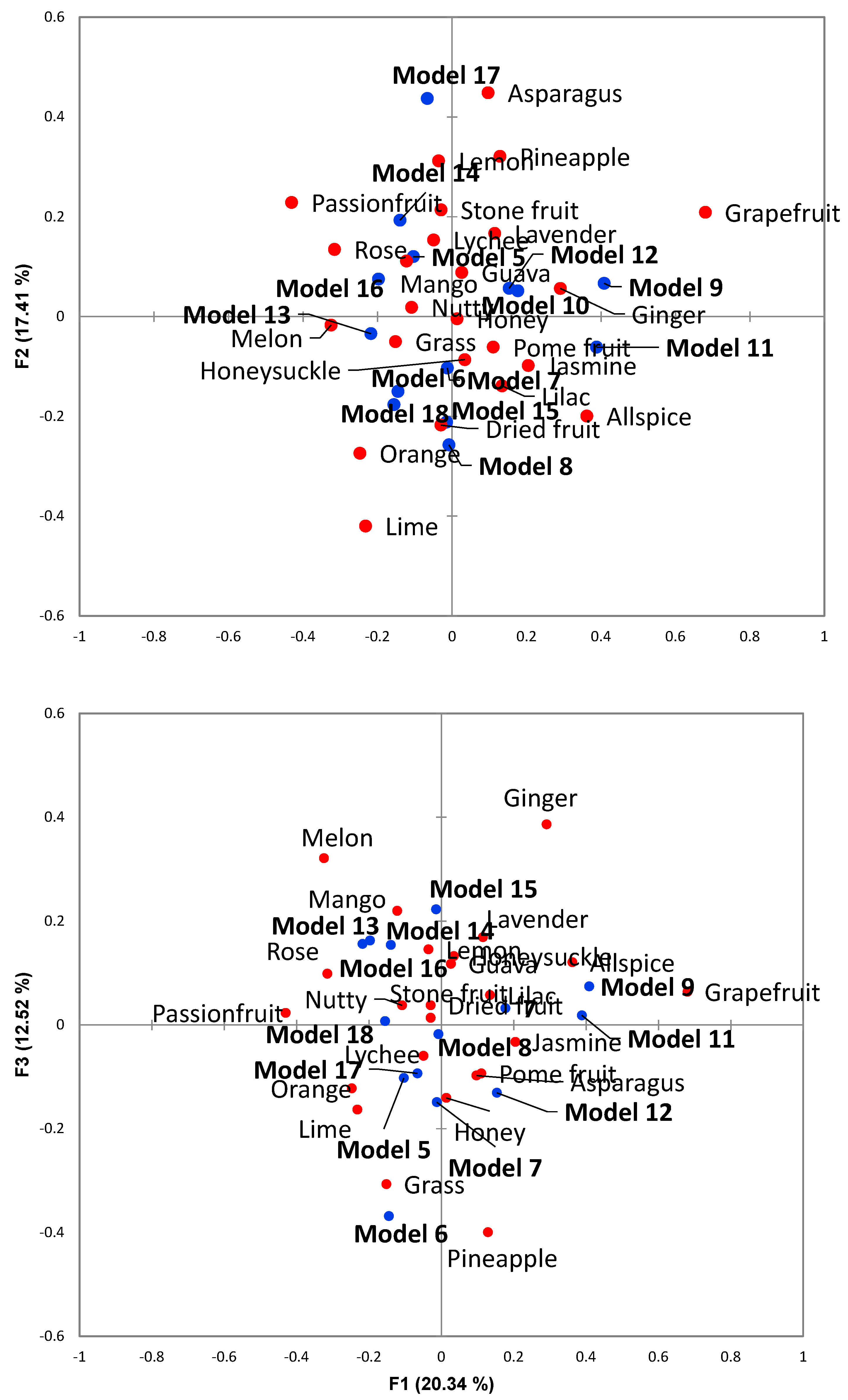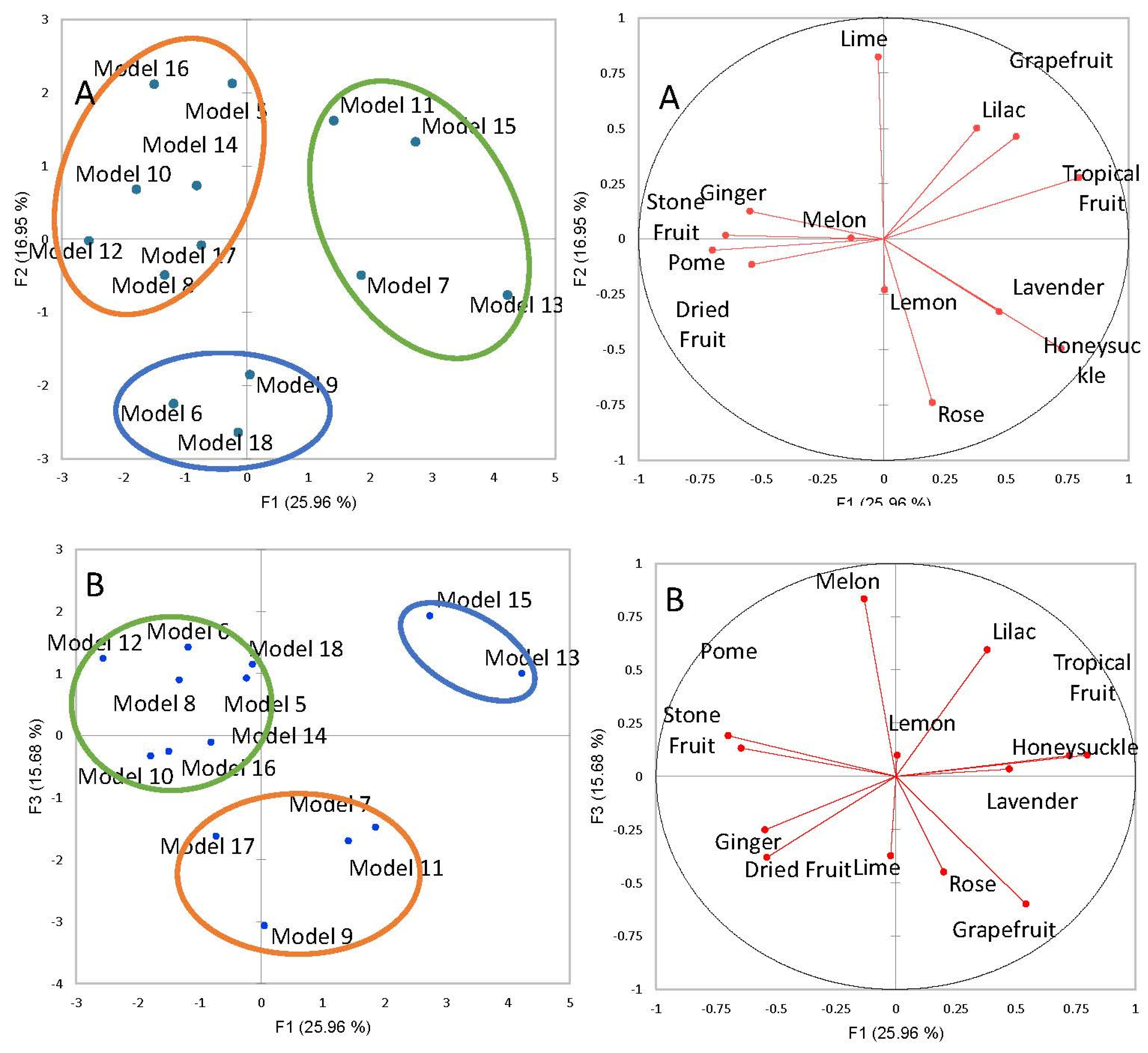Aroma Perception of Limonene, Linalool and α-Terpineol Combinations in Pinot Gris Wine
Abstract
1. Introduction
2. Materials and Methods
2.1. Chemicals
2.2. Wine Base
2.3. Standards and Wine Models
2.4. Sensory Analysis
2.5. Triangle Test Procedures
2.6. CATA
2.7. Descriptive Analysis for Aroma Intensity
2.8. Statistical Analysis
3. Results and Discussion
3.1. Triangle Tests
3.2. CATA
3.3. Descriptive Analysis
4. Conclusions
Supplementary Materials
Author Contributions
Funding
Institutional Review Board Statement
Informed Consent Statement
Data Availability Statement
Conflicts of Interest
References
- Michlmayr, H.; Nauer, S.; Brandes, W.; Schümann, C.; Kulbe, K.D.; del Hierro, A.M.; Eder, R. Release of wine monoterpenes from natural precursors by glycosidases from Oenococcus oeni. Food Chem. 2012, 135, 80–87. [Google Scholar] [CrossRef]
- Gump, B.H.; Pruett, D.J. Beer and wine production: Analysis, characterization, and technological advances. In ACS Symposium Series; American Chemical Society: Washington, DC, USA, 1993; p. 98. [Google Scholar]
- Vilanova, M.; Genisheva, Z.A.; Graña, M.; Oliveira, J.M. Determination of Odorants in Varietal Wines from International Grape Cultivars (Vitis vinifera) Grown in NW Spain. S. Afr. J. Enol. Vitic. 2013, 34, 212–222. [Google Scholar] [CrossRef]
- Terashini, R.; Buttery, R.G.; Shahidi, F. Enantioselectivity in Odor Perception. In Flavor Chemistry Trends and Development, 3rd ed.; ACS Symposium Series; American Chemical Society: Washington, DC, USA, 1989; pp. 155–157. [Google Scholar]
- Parker, M.; Black, C.A.; Barker, A.; Pearson, W.; Hayasaka, Y.; Francis, I.L. The contribution of wine-derived monoterpene glycosides to retronasal odour during tasting. Food Chem. 2017, 232, 413–424. [Google Scholar] [CrossRef] [PubMed]
- Chigo-Hernandez, M.M.; DuBois, A.; Tomasino, E. Aroma Perception of Rose Oxide, Linalool and α-Terpineol Combinations in Gewürztraminer Wine. Ferment 2022, 8, 30. [Google Scholar] [CrossRef]
- Song, M.; Fuentes, C.; Loos, A.; Tomasino, E. Free Monoterpene Isomer Profiles of Vitis vinifera, L. Cv. White Wines. Foods 2018, 7, 27. [Google Scholar] [CrossRef] [PubMed]
- Ferreira, V.; de la Fuente, A.; Sáenz-Navajas, M.P. Wine aroma vectors and sensory attributes. In Managing Wine Quality; Woodhead Publishing: Cambridge, MA, USA, 2022; pp. 3–39. [Google Scholar]
- Rapp, A. Volatile flavour of wine: Correlation between instrumental analysis and sensory perception. Food/Nahrung 1998, 42, 351–363. [Google Scholar] [CrossRef]
- Tomasino, E.; Song, M.; Fuentes, C. Odor Perception Interactions between Free Monoterpene Isomers and Wine Composition of Pinot Gris Wines. J. Agric. Food Chem. 2020, 68, 3220–3227. [Google Scholar] [CrossRef] [PubMed]
- Guth, H. Quantitation and sensory studies of character impact odorants of different white wine varieties. J. Agric. Food Chem. 1997, 45, 3027–3032. [Google Scholar] [CrossRef]
- Ferreira, V.; López, R.; Cacho, J.F. Quantitative determination of the odorants of young red wines from different grape varieties. J. Sci. Food Agric. 2000, 80, 1659–1667. [Google Scholar] [CrossRef]
- Francis, I.L.; Newton, J.L. Determining wine aroma from compositional data. Aust. J. Grape Wine Res. 2005, 11, 114–126. [Google Scholar] [CrossRef]
- LaVilla, J. The Wine, Beer, & Spirits Handbook: A Guide to Styles and Service; John Wiley and Sons: Hoboken, NJ, USA, 2009; pp. 199–486. [Google Scholar]
- Luo, J.; Brotchie, J.; Pang, M.; Marriott, P.J.; Howell, K.; Zhang, P. Dataset of concentrations of free terpenes at different phenological stages in Vitis vinifera L. Shiraz, Cabernet Sauvignon, Riesling, Chardonnay and Pinot Gris. Data Brief 2019, 27, 104595. [Google Scholar] [CrossRef] [PubMed]
- Luo, J.; Brotchie, J.; Pang, M.; Marriott, P.J.; Howell, K.; Zhang, P. Free terpene evolution during the berry maturation of five Vitis vinifera L. cultivars. Food Chem. 2019, 299, 125101. [Google Scholar] [CrossRef] [PubMed]
- Friedman, L.; Miller, J.G. Odor incongruity and chirality. Science 1971, 172, 1044–1046. [Google Scholar] [CrossRef] [PubMed]
- Ohloff, G. Scent and Fragrances; Springer: Berlin/Heidelberg, Germany, 1994; p. 43. [Google Scholar]
- Boelens, M.H.; Boelens, H.; van Gemert, L.J. Sensory Properties of Optical Isomers. Perfum. Flavorist 1993, 18, 1–15. [Google Scholar]
- Iobbi, A.; Tomasino, E. Tropical Fruit Aroma: Revealing the Sensory Impact of Different Levels of Esters and Volatile Thiols and Their Combination Effect in White Wines. Heliyon 2022, 9, e12862. [Google Scholar] [CrossRef] [PubMed]
- Laska, M.; Teubner, P. Olfactory discrimination ability of human subjects for ten pairs of enantiomers. Chem. Senses 1999, 24, 161–170. [Google Scholar] [CrossRef] [PubMed]
- Burdock, G.A.; Fenaroli, G. Fenaroli’s Handbook of Flavor Ingredients; Taylor & Francis Group: Milton Park, UK, 2009; p. 1090. [Google Scholar]
- Belitz, H.D.; Grosch, W.; Schieberle, P. Aroma compounds. In Food Chemistry; Springer: Berlin/Heidelberg, Germany, 2004; p. 343. [Google Scholar]
- Ahmed, E.M.; Dennison, R.A.; Dougherty, R.H.; Shaw, P.E. Effect of nonvolatile orange juice components, acid, sugar, and pectin on the flavor threshold of d-limonene in water. J. Agric. Food Chem. 1978, 26, 192–194. [Google Scholar] [CrossRef]
- Van Gemert, L. Odour Thresholds: Compilations of Odour Threshold Values in Air, Water and Other Media, 2nd ed.; Oliemans Punter & Partners BV: Utrecht, The Netherlands, 2011; pp. 288–289. [Google Scholar]
- Lawless, H.; Heymann, H. Sensory Evaluation of Food: Principles and Practices, 2nd ed.; Springer: New York, NY, USA, 2010; pp. 21–125. [Google Scholar]
- Negro, V.; Mancini, G.; Ruggeri, B.; Fino, D. Citrus waste as feedstock for bio-based products recovery: Review on limonene case study and energy valorization. Bioresour. Technol. 2016, 214, 806–815. [Google Scholar] [CrossRef] [PubMed]
- Buettner, A. Springer Handbook of Odor; Springer: New York, NY, USA, 2017; p. 113. [Google Scholar]
- Dušková, E.; Dušek, K.; Indrák, P.; Smékalová, K. Postharvest changes in essential oil content and quality of lavender flowers. Ind. Crops Prod. 2016, 79, 225–231. [Google Scholar] [CrossRef]


| Wines | (S)-(−)-Limonene | (R)-(+)-Limonene | Linalool | α-Terpineol |
|---|---|---|---|---|
| Model 1 a | 1.32 | 2.68 | ||
| Model 2 b | 2.2 | 1.8 | ||
| Model 3 c | 2.68 | 1.32 | ||
| Model 4 d | 3.16 | 0.84 | ||
| Model 5 b | 1.1 | 0.9 | ||
| Model 6 b | 1.1 | 0.9 | 25 | |
| Model 7 b | 1.1 | 0.9 | 30 | |
| Model 8 b,e | 1.1 | 0.9 | 25 | 30 |
| Model 9 b | 4.95 | 4.05 | ||
| Model 10 b | 4.95 | 4.05 | 13 | |
| Model 11 b | 4.95 | 4.05 | 15 | |
| Model 12 b,f | 4.95 | 4.05 | 13 | 15 |
| Model 13 b | 4.95 | 4.05 | 45 | |
| Model 14 b | 4.95 | 4.05 | 62 | |
| Model 15 b,g | 4.95 | 4.05 | 45 | 62 |
| Model 16 | 25 | |||
| Model 17 | 30 | |||
| Model 18 |
| Attribute | Amount Per Glass | Components | Image |
|---|---|---|---|
| Dried Fruit a | 1 tsp * | Golden raisins mixed with DI water |  |
| Honey Suckle | 2 drops in cotton | Honeysuckle essential oil b |  |
| Stone Fruit | 1 tsp of each | White peach c and apricot puree c |  |
| Tropical Fruit | 1 tsp of each | Mango c and passion fruit puree c |  |
| Pome | 1 tsp of each | Green apple c and pear puree c |  |
| Rose | 4 drops | Rosewater concentrate d |  |
| Melon | 1 tsp and 1 drop of each | Honeydew puree e made and melon essential oil f |  |
| Ginger | 1 tsp | Ground ginger g |  |
| Lemon | 1 tsp | Lemon pure made h and lemon essential oil b |  |
| Grapefruit | 1 tsp | Grapefruit pure made h |  |
| Lime | 1 tsp | Lime pure made h |  |
| Lilac | 1 drop in cotton | Lilac essential oil i |  |
| Lavender | 1 drop in cotton | Lavender essential oil i |  |
| Comparison | Number of Participants | Number of Correct Responses | p-Value |
|---|---|---|---|
| Model 1 vs. Model 2 | 59 | 19 | >0.5 |
| Model 1 vs. Model 3 | 59 | 14 | >0.6 |
| Model 1 vs. Model 4 | 59 | 17 | >0.7 |
| Model 2 vs. Model 3 | 59 | 24 | 0.14 |
| Model 2 vs. Model 4 | 59 | 19 | >0.9 |
| Model 3 vs. Model 4 | 59 | 17 | >0.10 |
Disclaimer/Publisher’s Note: The statements, opinions and data contained in all publications are solely those of the individual author(s) and contributor(s) and not of MDPI and/or the editor(s). MDPI and/or the editor(s) disclaim responsibility for any injury to people or property resulting from any ideas, methods, instructions or products referred to in the content. |
© 2023 by the authors. Licensee MDPI, Basel, Switzerland. This article is an open access article distributed under the terms and conditions of the Creative Commons Attribution (CC BY) license (https://creativecommons.org/licenses/by/4.0/).
Share and Cite
Chigo-Hernandez, M.M.; Tomasino, E. Aroma Perception of Limonene, Linalool and α-Terpineol Combinations in Pinot Gris Wine. Foods 2023, 12, 2389. https://doi.org/10.3390/foods12122389
Chigo-Hernandez MM, Tomasino E. Aroma Perception of Limonene, Linalool and α-Terpineol Combinations in Pinot Gris Wine. Foods. 2023; 12(12):2389. https://doi.org/10.3390/foods12122389
Chicago/Turabian StyleChigo-Hernandez, Mildred Melina, and Elizabeth Tomasino. 2023. "Aroma Perception of Limonene, Linalool and α-Terpineol Combinations in Pinot Gris Wine" Foods 12, no. 12: 2389. https://doi.org/10.3390/foods12122389
APA StyleChigo-Hernandez, M. M., & Tomasino, E. (2023). Aroma Perception of Limonene, Linalool and α-Terpineol Combinations in Pinot Gris Wine. Foods, 12(12), 2389. https://doi.org/10.3390/foods12122389





